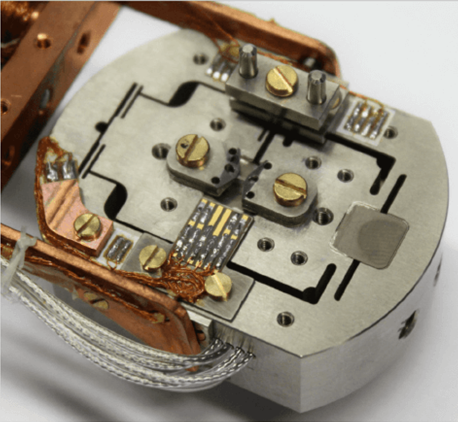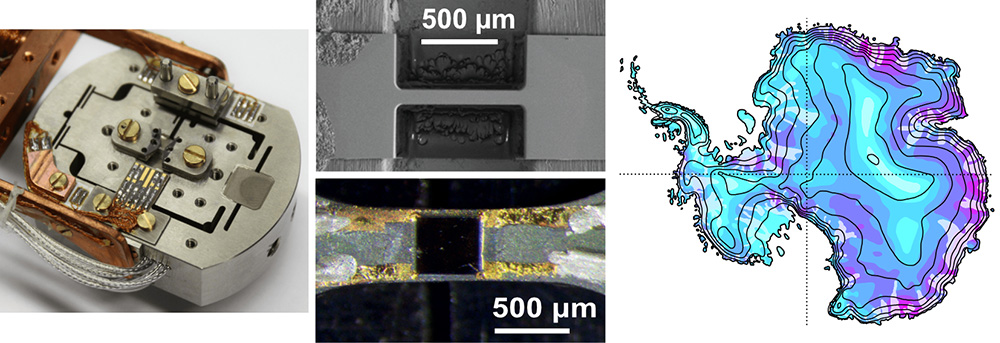
Our group specialises in technically challenging measurements on correlated electron materials, such as superconductors. Our research is based primarily around stress-tuning: using adjustable uniaxial stress to study how electronic properties vary with lattice parameter. In a separate line of research, we also investigate methods for direct air capture of CO2, with the ultimate goal of reversing climate change.
PhD and postdoc opportunities
You should join our group if you like hands-on experimentation. We build the apparatus that we need, wire the cryostats, and program the measurement software ourselves. This is an opportunity not just to deepen your knowledge of condensed matter physics, but also to learn a lot of engineering fundamentals, and especially the most basic and the hardest skill of turning an idea into something that you can hold in your hands and rely upon. Please email Dr Clifford Hicks at the address below to arrange a discussion. Open PhD studentships are listed on the central University Find a PhD page, but informal discussions are welcomed at any time.
Useful links
Dr Clifford Hicks' staff page
Dr Clifford Hicks' research portal
Contact: c.hicks.1@bham.ac.uk
Research
Our most important tool is controlled lattice distortion, using home-built piezoelectric-based uniaxialpressure cells. The first version of these cells was developed by our group in 2012 [1]. In that first experiment, we reached a maximum uniaxial stress of about 0.3 GPa.
Since then, we have developed both the stress apparatus and the sample preparation methods, so that we can reliably reach stresses exceeding 2 GPa. This is sufficient to distort even hard oxide materials such as Sr2RuO4 or YBa2Cu3O6+x by more than 1%. That well exceeds the elastic limit of most high-strength metallic alloys. We are able to keep the distortion elastic through careful sample preparation, and by applying the stress only at low temperatures, where the activation energy for creating dislocations is higher. To grasp more concretely what a uniaxial stress of 2 GPa means, imagine taking a metre stick made of granite, and applying enough stress to it to compress it by 1 cm.
The goal of this effort is to change electronic structures, and to observe how electronic properties change in response. For example, Sr2RuO4 is a superconductor below 1.5 K, and although that is not a high critical temperature it remains an almost complete mystery why this compound is a superconductor at all. We do not know the pairing mechanism, and contradictions in various experimental results on the superconductivity indicate that there is a high chance that it is something altogether new. By applying a uniaxial stress of ~1 GPa, one of the Fermi surfaces of Sr2RuO4 can be driven through a topological transition. At the transition point, the superconductivity is very strongly enhanced [2], and that observation sets a powerful constraint on the order parameter. Beyond this transition, the superconductivity is very rapidly suppressed. In effect, we are able to study not just the compound that nature has given us, but also a whole chain of compounds, connected by a continuous tuning parameter, and the additional data provides stronger constraints on theoretical proposals. The capacity of uniaxial stress to alter electronic structures approaches what can be achieved with doping,but with the great advantage that no additional disorder is introduced into the sample.
For cuprate superconductors, it is arguably more informative to find ways to weaken than to enhance the superconductivity. Antiferromagnetic spin fluctuations certainly play a strong role in the pairing; what is not clear is what other ingredients are necessary to obtain high-temperature superconductivity, and one way to study that is to suppress the superconductivity and see what other electronically ordered phases appear. We have shown that application of uniaxial stress can suppress the superconductivity and induce static charge density wave order in YBa2Cu3O6+x [3], an observation that raises the question of whether this charge density wave order is simply something else that the mobile particles can do, or whether fluctuations of this charge order are also an integral part of the superconductivity.
The nematicity of FeSe is another mystery in condensed matter physics where uniaxial stress is proving to be informative. FeSe is structurally a very simple compound, with no intrinsic dopant disorder. At 90 K, it undergoes a structural transition from a tetragonal to an orthorhombic lattice symmetry, and it is understood that this transition is driven by the mobile charge carriers, but precisely how is not known. One theory is that the quantum zero-point energy of spin fluctuations drives the transition: going through the transition creates a larger phase space for spin fluctuations, reducing the zero-point energy. However, by inducing strong nematicity through application of uniaxial stress we have shown that the resistive anisotropy does not evolve in a way one would straightforwardly predict from this theory [4].
Our group has also looked at magnetic compounds such as PdCrO2 and Mn3Pt. For a complete list of publications, please look at the Condensed Matter group publications page.
[1] CWH et al, Science 344, 283 (2014).
[2] Steppke et al, Science 355, eaaf9398 (2017).
[3] Kim et al, Science 362, 1040 (2018).
[4] Bartlett et al, Phys. Rev. X 11, 021038 (2021).
Group members
- Nina Stilkerich, Ph.D. candidate
- Felix Baylis, Ph. D. candidate
Former group members
- Kousuke Ishida, PDRA
- Belén Zúñiga, Ph.D. 2022
- Hilary Noad, PDRA
- Po-Ya Yang, Ph.D. 2022
- Kent Shirer, PDRA
- Fabian Jerzembeck, Ph.D. 2020
- Jack Bartlett, Ph.D. 2019
- Dan Sun, PDRA
- Joonbum Park, PDRA
- Mark Barber, Ph.D. 2017
- Daniel Brodsky, Ph.D. 2015
- Alexander Steppke, PDRA
Visual examples of our research
A sample of Sr2RuO4 sculpted by F. Jerzembeck with an ion beam for application of stress along the c axis
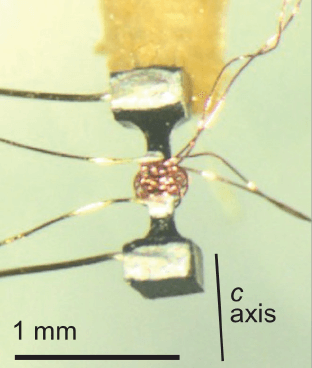
The Hall effect in Sr2RuO4. Under uniaxial stress, Sr2RuO4 becomes a much less correlated metal. P. Yang.
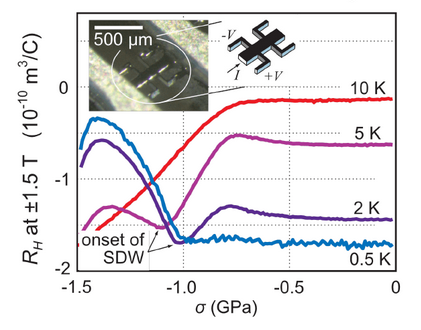
A sample of FeSe, mounted on a platform for strain experiments by A. Steppke
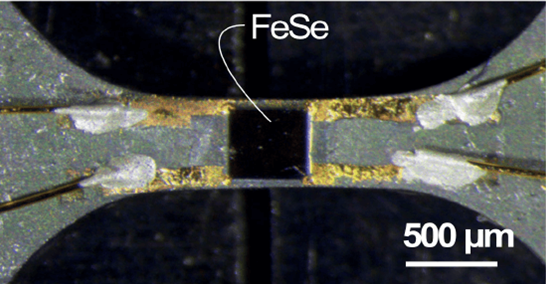
The magnetic structure of PdCrO2. It is a triangular anti-ferromagnet. Under uniaxial stress, it becomes incommensurate
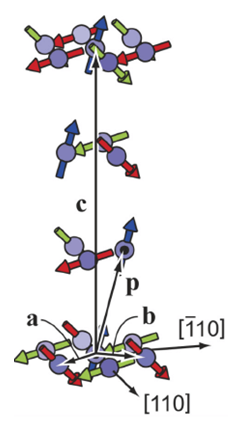
The magnetoelastic effect in Mn3Pt: under uniaxial stress, Mn3Pt picks up a ferromagnetic moment. B. Zuniga
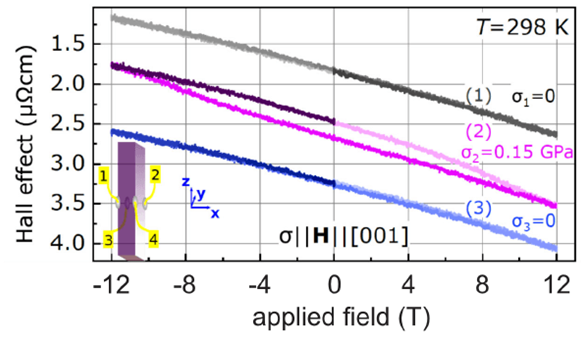
Stress-strain measurements on Sr2RuO4, performed by H. Noad. The Young's modulus dips sharply at the Fermi surface topological transition
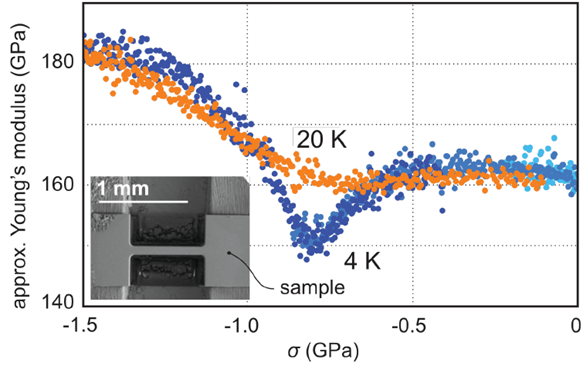
One of the uniaxial stress cells that our group uses. This cell contains both force and displacement sensors
